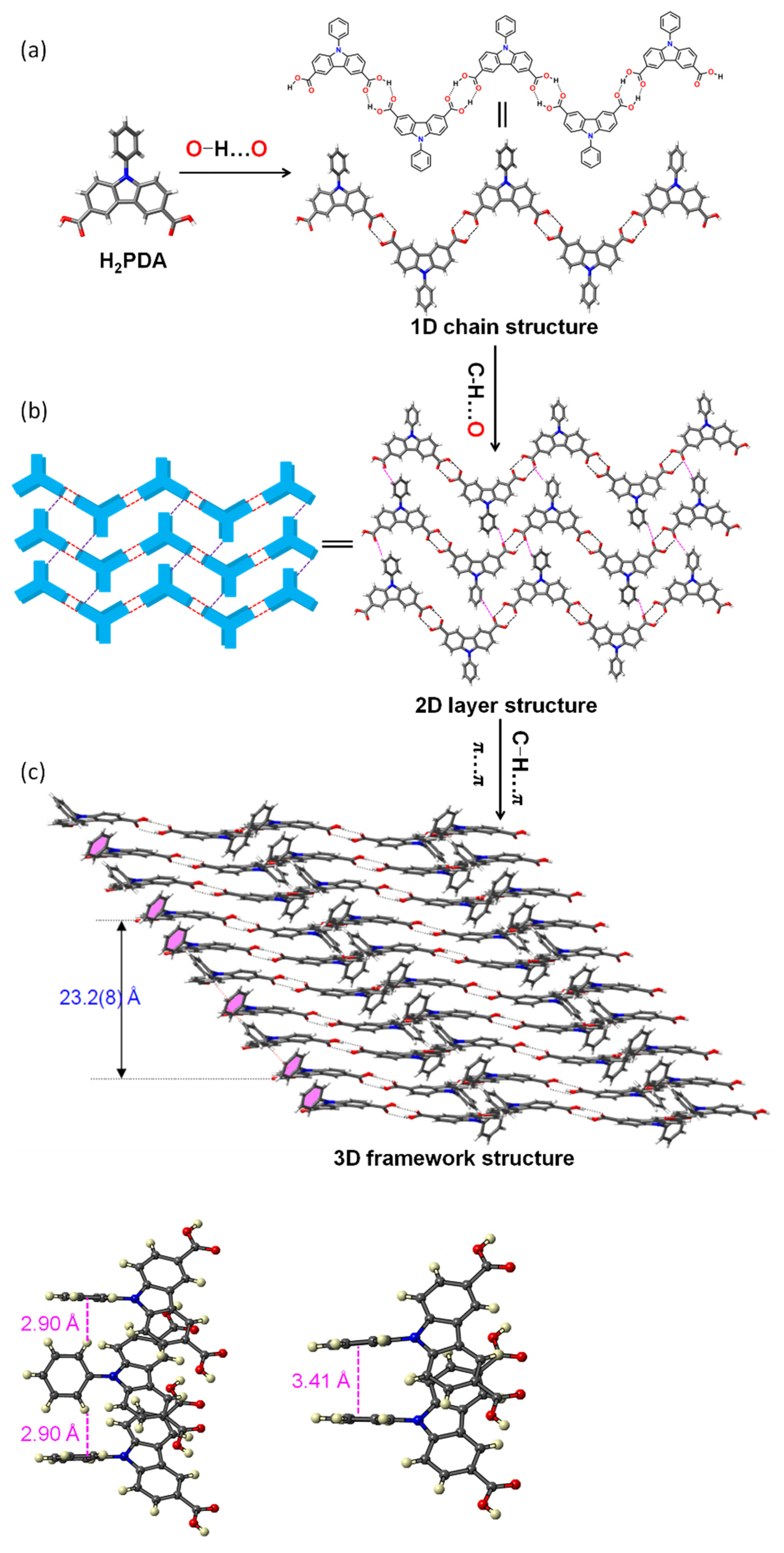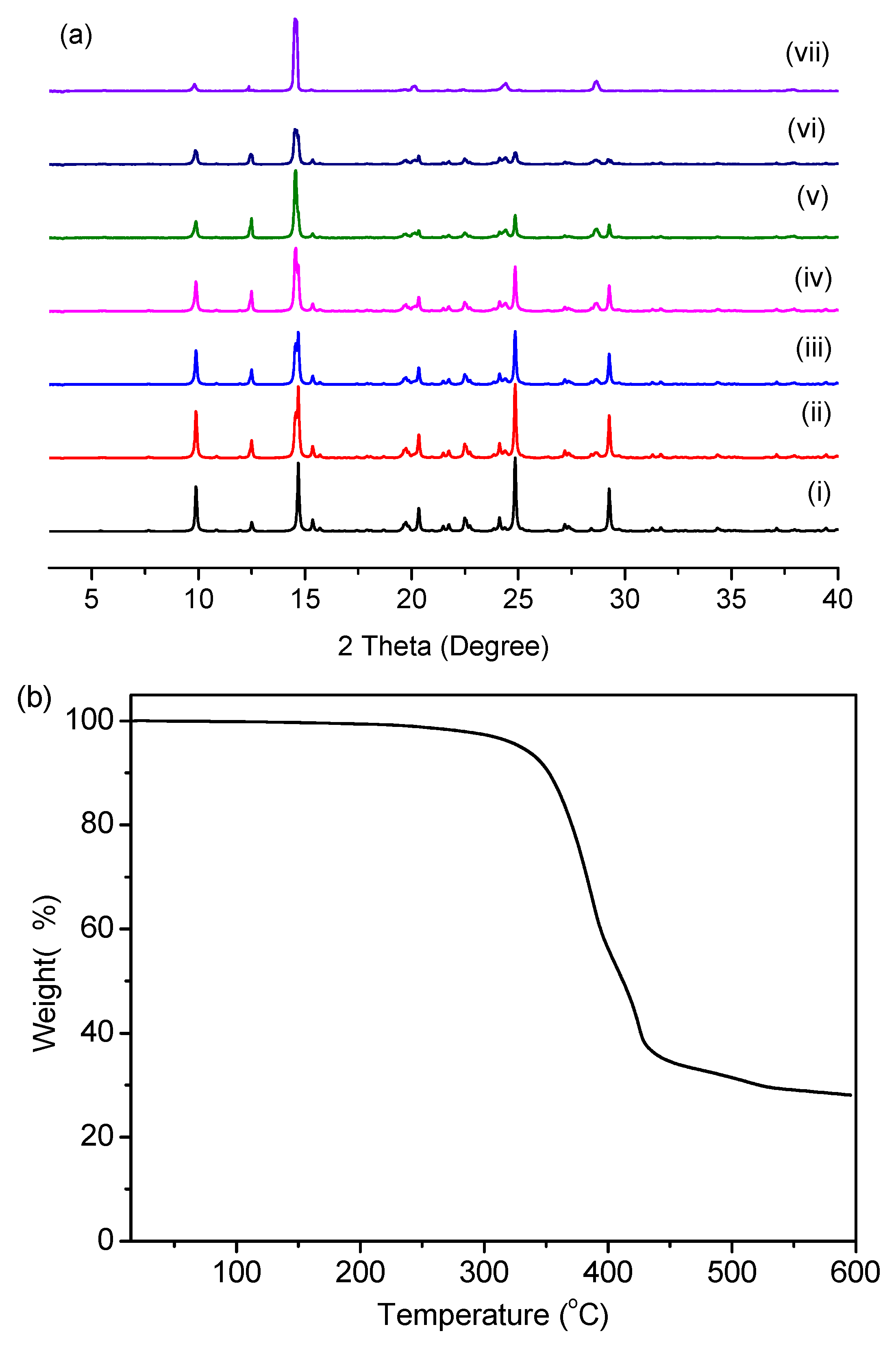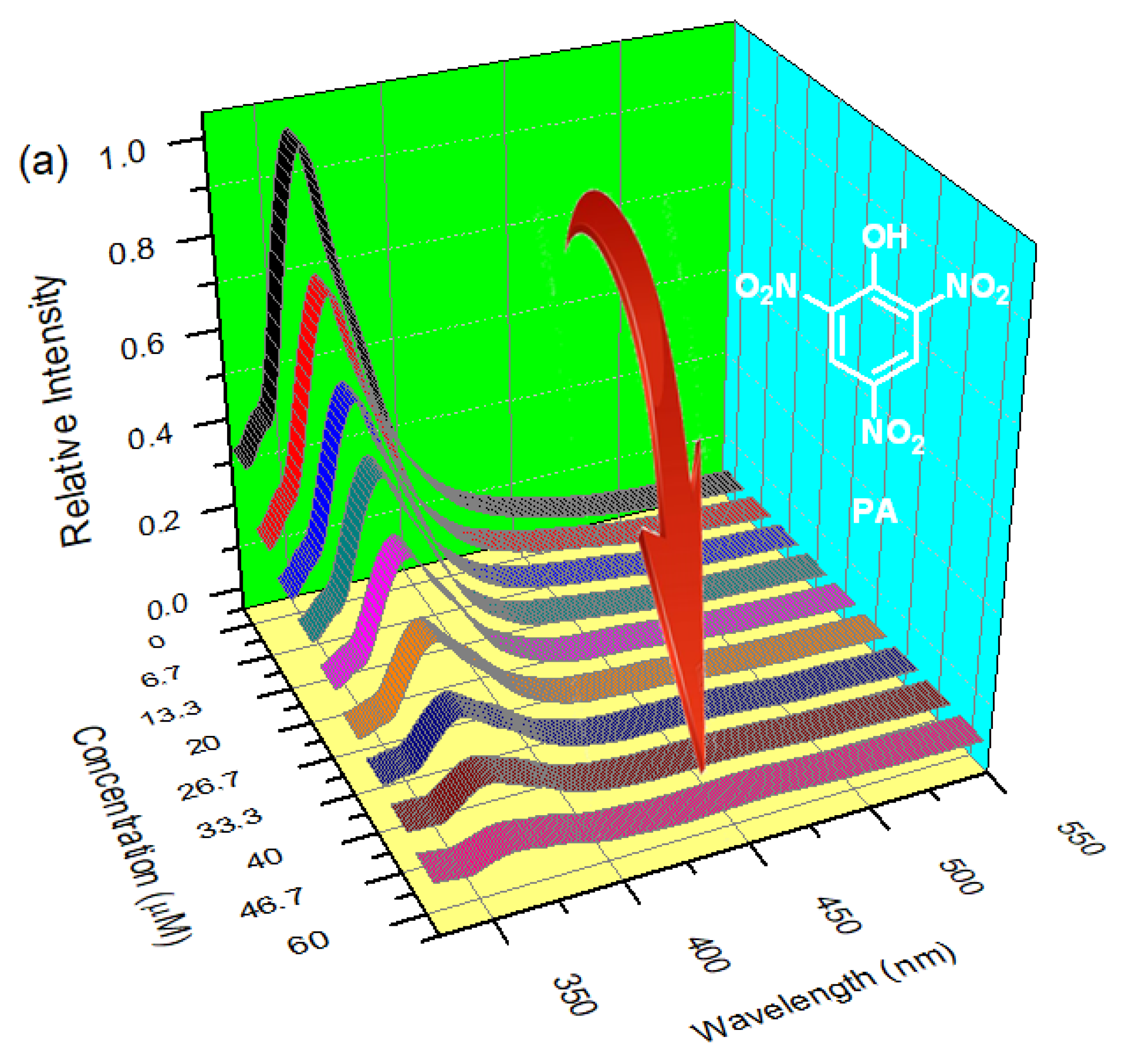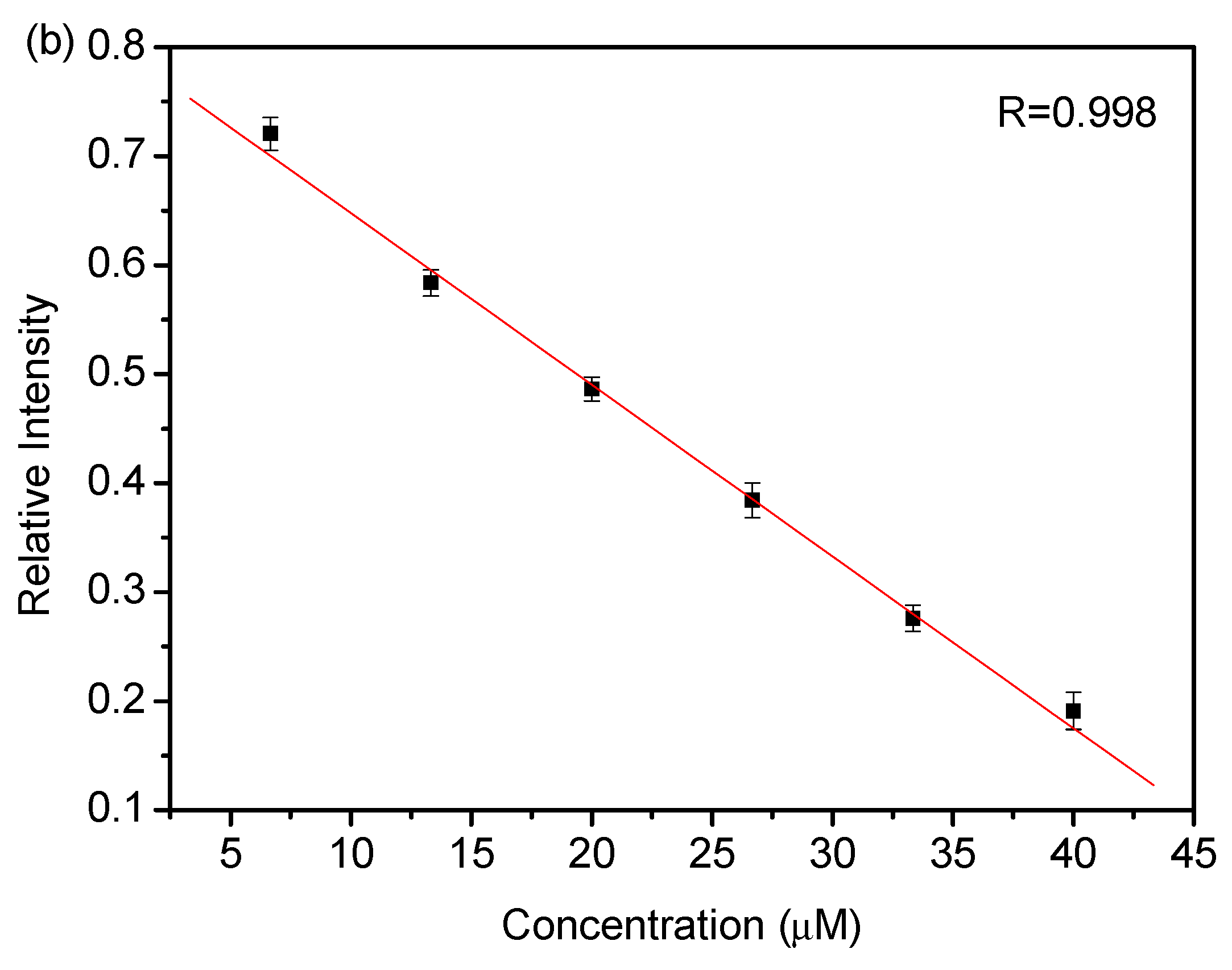An Ultrasensitive Picric Acid Sensor Based on a Robust 3D Hydrogen-Bonded Organic Framework
Abstract
:1. Introduction
2. Experiments and Materials
Synthesis of HOF-1
3. Results and Discussion
3.1. Characterization of HOF-1
3.2. Sensing of PA
4. Conclusions
Supplementary Materials
Author Contributions
Funding
Institutional Review Board Statement
Informed Consent Statement
Data Availability Statement
Conflicts of Interest
References
- Lin, R.-B.; He, Y.; Li, P.; Wang, H.; Zhou, W.; Chen, B. Multifunctional porous hydrogen-bonded organic framework materials. Chem. Soc. Rev. 2019, 48, 1362–1389. [Google Scholar] [CrossRef] [PubMed]
- Hisaki, I.; Xin, C.; Takahashi, K.; Nakamura, T. Designing Hydrogen-Bonded Organic Frameworks (HOFs) with Permanent Porosity. Angew. Chem. Int. Ed. 2019, 58, 11160–11170. [Google Scholar] [CrossRef] [PubMed]
- Wang, B.; Lin, R.-B.; Zhang, Z.; Xiang, S.; Chen, B. Hydrogen-Bonded Organic Frameworks as a Tunable Platform for Functional Materials. J. Am. Chem. Soc. 2020, 142, 14399–14416. [Google Scholar] [CrossRef] [PubMed]
- Wang, Y.; Hou, X.; Liu, C.; Albolkany, M.K.; Wang, Y.; Wu, N.; Chen, C.; Liu, B. Combustible ice mimicking behavior of hydrogen-bonded organic framework at ambient condition. Nat. Commun. 2020, 11, 3124. [Google Scholar] [CrossRef]
- Takeda, T.; Ozawa, M.; Akutagawa, T. Jumping Crystal of a Hydrogen-Bonded Organic Framework Induced by the Collective Molecular Motion of a Twisted pi System. Angew. Chem. Int. Ed. 2019, 58, 10345–10352. [Google Scholar] [CrossRef]
- Yin, Q.; Zhao, P.; Sa, R.J.; Chen, G.C.; Lu, J.; Liu, T.F.; Cao, R. An Ultra-Robust and Crystalline Redeemable Hydrogen-Bonded Organic Framework for Synergistic Chemo-Photodynamic Therapy. Angew. Chem. Int. Ed. 2018, 57, 7691–7696. [Google Scholar] [CrossRef]
- Bao, Z.; Xie, D.; Chang, G.; Wu, H.; Li, L.; Zhou, W.; Wang, H.; Zhang, Z.; Xing, H.; Yang, Q.; et al. Fine Tuning and Specific Binding Sites with a Porous Hydrogen-Bonded Metal-Complex Framework for Gas Selective Separations. J. Am. Chem. Soc. 2018, 140, 4596–4603. [Google Scholar] [CrossRef]
- Li, Y.L.; Alexandrov, E.V.; Yin, Q.; Li, L.; Fang, Z.B.; Yuan, W.B.; Proserpio, D.M.; Liu, T.F. Record Complexity in the Polycatenation of Three Porous Hydrogen-Bonded Organic Frameworks with Stepwise Adsorption Behaviors. J. Am. Chem. Soc. 2020, 142, 7218–7224. [Google Scholar] [CrossRef]
- Yang, Y.S.; Li, L.B.; Lin, R.B.; Ye, Y.X.; Yao, Z.Z.; Yang, L.; Xiang, F.H.; Chen, S.M.; Zhang, Z.J.; Xiang, S.C.; et al. Ethylene/ethane separation in a stable hydrogen-bonded organic framework through a gating mechanism. Nat. Chem. 2021, 13, 933–939. [Google Scholar] [CrossRef]
- Cai, S.Z.; Shi, H.F.; Zhang, Z.Y.; Wang, X.; Ma, H.L.; Gan, N.; Wu, Q.; Cheng, Z.C.; Ling, K.; Gu, M.X.; et al. Hydrogen-Bonded Organic Aromatic Frameworks for Ultralong Phosphorescence by Intralayer pi-pi Interaction. Angew. Chem. Int. Ed. 2018, 57, 4005–4009. [Google Scholar] [CrossRef]
- Hisaki, I.; Suzuki, Y.; Gomez, E.; Ji, Q.; Tohnai, N.; Nakamura, T.; Douhal, A. Acid Responsive Hydrogen-Bonded Organic Frameworks. J. Am. Chem. Soc. 2019, 141, 2111–2121. [Google Scholar] [CrossRef] [PubMed]
- Sun, Z.Y.; Li, Y.X.; Chen, L.; Jing, X.B.; Xie, Z.G. Fluorescent Hydrogen-Bonded Organic Framework for Sensing of Aromatic Compounds. Cryst. Growth Des. 2015, 15, 542–545. [Google Scholar] [CrossRef]
- Wang, H.L.; Bao, Z.B.; Wu, H.; Lin, R.B.; Zhou, W.; Hu, T.L.; Li, B.; Zhao, J.C.-G.; Chen, B. Two solvent-induced porous hydrogen-bonded organic frameworks: Solvent effects on structures and functionalities. Chem. Commun. 2017, 53, 11150–11153. [Google Scholar] [CrossRef]
- Zhou, H.; Ye, Q.; Wu, X.Y.; Song, J.; Cho, C.M.; Zong, Y.; Tang, B.Z.; Hor, T.S.A.; Yeow, E.K.L.; Xu, J.W. A thermally stable and reversible microporous hydrogen-bonded organic framework: Aggregation induced emission and metal ion-sensing properties. J. Mater. Chem. C 2015, 3, 11874–11880. [Google Scholar] [CrossRef]
- Han, Y.N.; Zhang, T.; Chen, X.Y.; Chen, Q.; Hao, J.J.; Song, W.C.; Zeng, Y.F.; Xue, P.C. Guest-Regulated Luminescence and Force-Stimuli Response of a Hydrogen-Bonded Organic Framework. ACS Appl. Mater. Interfaces 2021, 13, 32270–32277. [Google Scholar] [CrossRef] [PubMed]
- Peng, J.M.; Wang, H.L.; Zhu, Z.H.; Liu, Z.Y.; Zou, H.H.; Liang, F.P. Substituents lead to differences in the formation of a series of dysprosium hydrogen-bonded organic frameworks with high stability and acid stimulus-response luminescence properties. J. Mater. Chem. C 2021, 9, 9319–9330. [Google Scholar] [CrossRef]
- Chen, T.H.; Kaveevivitchai, W.; Jacobson, A.J.; Miljanic, O.S. Adsorption of fluorinated anesthetics within the pores of a molecular crystal. Chem. Commun. 2015, 51, 14096–14098. [Google Scholar] [CrossRef]
- Zhang, N.; Wang, X.T.; Xiong, Z.P.; Huang, L.Y.; Jin, Y.; Wang, A.J.; Yuan, P.X.; He, Y.B.; Feng, J.J. Hydrogen Bond Organic Frameworks as a Novel Electrochemiluminescence Luminophore: Simple Synthesis and Ultrasensitive Biosensing. Anal. Chem. 2021, 93, 17110–17118. [Google Scholar] [CrossRef]
- Gong, W.; Chu, D.; Jiang, H.; Chen, X.; Cui, Y.; Liu, Y. Permanent porous hydrogen-bonded frameworks with two types of Bronsted acid sites for heterogeneous asymmetric catalysis. Nat. Commun. 2019, 10, 600. [Google Scholar] [CrossRef]
- Han, B.; Wang, H.L.; Wang, C.M.; Wu, H.; Zhou, W.; Chen, B.; Jiang, J.Z. Postsynthetic Metalation of a Robust Hydrogen-Bonded Organic Framework for Heterogeneous Catalysis. J. Am. Chem. Soc. 2019, 141, 8737–8740. [Google Scholar] [CrossRef]
- Jones, J.T.A.; Hasell, T.; Wu, X.F.; Bacsa, J.; Jelfs, K.E.; Schmidtmann, M.; Chong, S.Y.; Adams, D.J.; Trewin, A.; Schiffman, F.; et al. Modular and predictable assembly of porous organic molecular crystals. Nature 2011, 474, 367–371. [Google Scholar] [CrossRef] [PubMed]
- Karmakar, A.; Illathvalappil, R.; Anothumakkool, B.; Sen, A.; Samanta, P.; Desai, A.V.; Kurungot, S.; Ghosh, S.K. Hydrogen-Bonded Organic Frameworks (HOFs): A New Class of Porous Crystalline Proton-Conducting Materials. Angew. Chem. Inter. Ed. 2016, 55, 10667–10671. [Google Scholar] [CrossRef] [PubMed]
- Xu, X.Q.; Cao, L.H.; Yang, Y.; Zhao, F.; Bai, X.T.; Zang, S.Q. Hybrid Nafion Membranes of Ionic Hydrogen-Bonded Organic Framework Materials for Proton Conduction and PEMFC Applications. ACS Appl. Mater. Interfaces 2021, 13, 56566–56574. [Google Scholar] [CrossRef] [PubMed]
- Bracco, S.; Asnaghi, D.; Negroni, M.; Sozzani, P.; Comotti, A. Porous dipeptide crystals as volatile-drug vessels. Chem. Commun. 2018, 54, 148–151. [Google Scholar] [CrossRef]
- Distefano, G.; Comotti, A.; Bracco, S.; Beretta, M.; Sozzani, P. Porous Dipeptide Crystals as Polymerization Nanoreactors. Angew. Chem. Int. Ed. 2012, 51, 9258–9262. [Google Scholar] [CrossRef]
- Zhang, Z.Q.; Li, J.; Yao, Y.H.; Sun, S. Permanently Porous Co(II) Porphyrin-Based Hydrogen Bonded Framework for Gas Adsorption and Catalysis. Cryst. Growth Des. 2015, 15, 5028–5033. [Google Scholar] [CrossRef]
- Hu, F.; Liu, C.; Wu, M.; Pang, J.; Jiang, F.; Yuan, D.; Hong, M. An Ultrastable and Easily Regenerated Hydrogen-Bonded Organic Molecular Framework with Permanent Porosity. Angew. Chem. Int. Ed. 2017, 56, 2101–2104. [Google Scholar] [CrossRef]
- Song, X.; Wang, Y.; Wang, C.; Wang, D.; Zhuang, G.; Kirlikovali, K.O.; Li, P.; Farha, O.K. Design Rules of Hydrogen-Bonded Organic Frameworks with High Chemical and Thermal Stabilities. J. Am. Chem. Soc. 2022, 144, 10663–10687. [Google Scholar] [CrossRef]
- Gao, X.-Y.; Li, Y.-L.; Liu, T.-F.; Huang, X.-S.; Cao, R. Single-crystal-to-single-crystal transformation of tetrathiafulvalene-based hydrogen-bonded organic frameworks. Crystengcomm 2021, 23, 4743–4747. [Google Scholar] [CrossRef]
- Veselovsky, V.V.; Lozanova, A.V.; Isaeva, V.I.; Nissenbaum, V.D.; Davshan, N.A.; Lobova, A.A.; Chernyshev, V.V. New Chiral Hydrogen-Bonded Organic Framework Based on Substituted Diarylacetylene Dicarboxylic Acid. Cryst. Growth Des. 2020, 20, 3713–3721. [Google Scholar] [CrossRef]
- Li, J.; Grimsdale, A.C. Carbazole-based polymers for organic photovoltaic devices. Chem. Soc. Rev. 2010, 39, 2399–2410. [Google Scholar] [CrossRef] [PubMed]
- Lai, W.-Y.; He, Q.-Y.; Chen, D.-Y.; Huang, W. Synthesis and Characterization of Starburst 9-Phenylcarbazole/Triazatruxene Hybrids. Chem. Lett. 2008, 37, 986–987. [Google Scholar] [CrossRef]
- Zhu, Z.G.; Moore, J.S. Synthesis and characterization of monodendrons based on 9-phenylcarbazole. J. Org. Chem. 2000, 65, 116–123. [Google Scholar] [CrossRef] [PubMed]
- Salinas, Y.; Martinez-Manez, R.; Marcos, M.D.; Sancenon, F.; Costero, A.M.; Parra, M.; Gil, S. Optical chemosensors and reagents to detect explosives. Chem. Soc. Rev. 2012, 41, 1261–1296. [Google Scholar] [CrossRef]
- Toal, S.J.; Trogler, W.C. Polymer sensors for nitroaromatic explosives detection. J. Mater. Chem. 2006, 16, 2871–2883. [Google Scholar] [CrossRef]
- Wu, P.; Jiang, M.; Li, Y.; Liu, Y.; Wang, J. Highly efficient photocatalytic hydrogen production from pure water via a photoactive metal–organic framework and its PDMS@MOF. J. Mater. Chem. A 2017, 5, 7833–7838. [Google Scholar] [CrossRef]
- Gautam, D.; Thomas, S. The Weak Hydrogen Bond; Oxford University Press: New York, NY, USA, 2001; pp. 108–113. [Google Scholar]





Publisher’s Note: MDPI stays neutral with regard to jurisdictional claims in published maps and institutional affiliations. |
© 2022 by the authors. Licensee MDPI, Basel, Switzerland. This article is an open access article distributed under the terms and conditions of the Creative Commons Attribution (CC BY) license (https://creativecommons.org/licenses/by/4.0/).
Share and Cite
Jiang, W.; Xia, L.; Li, D.; Wu, P.; Zou, T.; Yuan, X.; Wei, W.; Wang, J. An Ultrasensitive Picric Acid Sensor Based on a Robust 3D Hydrogen-Bonded Organic Framework. Biosensors 2022, 12, 682. https://doi.org/10.3390/bios12090682
Jiang W, Xia L, Li D, Wu P, Zou T, Yuan X, Wei W, Wang J. An Ultrasensitive Picric Acid Sensor Based on a Robust 3D Hydrogen-Bonded Organic Framework. Biosensors. 2022; 12(9):682. https://doi.org/10.3390/bios12090682
Chicago/Turabian StyleJiang, Weiwei, Lingling Xia, Dan Li, Pengyan Wu, Tongtong Zou, Xingcheng Yuan, Wen Wei, and Jian Wang. 2022. "An Ultrasensitive Picric Acid Sensor Based on a Robust 3D Hydrogen-Bonded Organic Framework" Biosensors 12, no. 9: 682. https://doi.org/10.3390/bios12090682
APA StyleJiang, W., Xia, L., Li, D., Wu, P., Zou, T., Yuan, X., Wei, W., & Wang, J. (2022). An Ultrasensitive Picric Acid Sensor Based on a Robust 3D Hydrogen-Bonded Organic Framework. Biosensors, 12(9), 682. https://doi.org/10.3390/bios12090682




